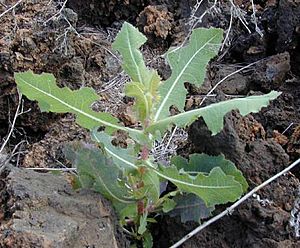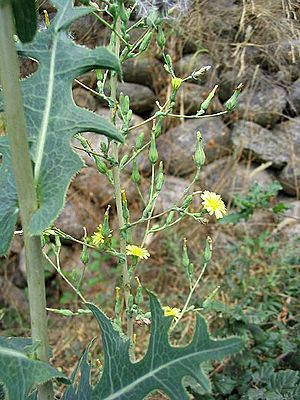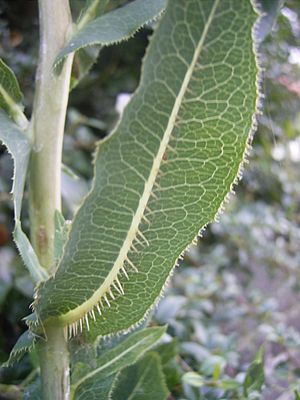Prickly lettuce facts for kids
Quick facts for kids Prickly lettuce |
|
|---|---|
 |
|
| Scientific classification | |
| Genus: |
Lactuca
|
| Species: |
serriola
|
| Synonyms | |
|
Synonymy
Lactuca altaica Fisch. & C.A.Mey.
Lactuca augustana All. Lactuca coriacea Sch.Bip. Lactuca dubia Jord. Lactuca integrata (Gren. & Godr.) A.Nelson Lactuca latifolia Boiss. Lactuca latifolia Gilib. Lactuca scariola L. Lactuca sylvestris Lam. Lactuca tephrocarpa K.Koch Lactuca verticalis Gaterau |
|
Lactuca serriola, also known as prickly lettuce, milk thistle, compass plant, and scarole, is a type of plant. It can live for one year (an annual) or two years (a biennial plant). This plant belongs to the Asteraceae family, which includes daisies and sunflowers.
Prickly lettuce has a slightly strong smell. Many people consider it a weed. You can often find it growing in orchards, along roads, and in farm fields. It is the closest wild relative to the lettuce we eat, called Lactuca sativa.
This plant is called the compass plant because its upper leaves twist. They turn to face the sun, holding their edges upright. This helps them stay cool and find the most sunlight.
Lactuca serriola originally comes from Europe, Asia, and north Africa. It has now spread and grows naturally in many other parts of the world.
Contents
What Prickly Lettuce Looks Like
Prickly lettuce has a reddish stem that does not have spines. Inside the stem, there is a milky white liquid called latex. The plant can grow quite tall, up to about 2 meters (6.5 feet).
The leaves get smaller as they go up the stem. They are usually long and narrow, or shaped like a spear. Many leaves have deep cuts or lobes. The lower leaves often have a waxy, grey-green color. Small spines can be found along the veins and edges of the leaves. The veins on the underside of the leaves are whitish. If you cut a leaf, it will release the milky latex.
The flowers are pale yellow and about 1 to 1.5 centimeters (0.4 to 0.6 inches) wide. They often have a purple tint. Each flower head has 12 to 20 ray flowers, which look like petals. The green parts that hold the flower (bracts) are also often tinged with purple. Prickly lettuce flowers from July to September in the northern parts of the world. After flowering, it produces small, grey seeds with bristles. These seeds have a white, feathery top called a pappus, which helps them fly in the wind.
How People Use Prickly Lettuce
You can eat Lactuca serriola in a salad, but it can taste a bit bitter. Young leaves are best eaten raw or cooked. Older leaves can be steamed to make them softer. Even the roots have been used as a coffee substitute when dried and ground.
Long ago, the Ancient Greeks thought the plant's strong juice could help with eye problems. After it arrived in North America, the Navajo started using it in special ceremonies. On the island of Crete in Greece, a type of prickly lettuce called maroula is boiled and eaten. Some Jewish people and Samaritans use it as the Maror (bitter herb) during the Pesach holiday.
Prickly lettuce contains a substance called lactucarium. This is the milky sap that comes from the plant's stem. When this sap dries after touching air, it can be used as a medicinal herb. While lactucarium is usually made from a different plant called Lactuca virosa, smaller amounts can also come from regular lettuce (Lactuca sativa) and Lactuca canadensis.
History of Prickly Lettuce
The ancient Egyptian god Min is connected to this type of lettuce. There isn't much old evidence of it in Greek history. However, some unburned seeds were found from the 7th century BC in a special place for the goddess Hera on Samos. The plant was also described by an ancient Greek writer named Theophrastus. In old stories, it is said that the goddess Aphrodite placed Adonis in a bed of lettuce. This led to the plant being linked with food for the dead.
See also
 In Spanish: Escarola para niños
In Spanish: Escarola para niños




